
Armour circa 1250
Reproduction armour patterned after David from folio 28 recto of the Maciejowski Bible. Shirt of flat rivetted mail with long sleeves, knee-length skirt with slits front and back and integral hood with ventail allowing a small face opening and to be fitted to the neck. Arms with extra rings forming a bent elbow and with tapered forarms. Helm of 5 pieces with cross applied to the center crease and eye-slots. Together with a padded coif, padded gorget, shirt, belts with custom buckles and mounts and a wooden sword. All clothing items of linen, hand-quilted. Armour made by Wade Allen. Clothing items by Tracy Justus. Constructed 2006.
Not for sale.

Armour circa 1340
Patterned after images from the Romance of Alexander (Ms. Bodley 264) and related brasses from 1330-1350. Composed of a bascinet closely patterned after the tall rounded bascinets with small face holes, short sides and central crease in the Romance of Alexander with an aventail formed of two trapezoids (rear one slightly larger to account for the breadth of the back) with extensions at the face. Trapezoids with forty five degree taper (one extra ring per row) on each side. Aventail secured to a leather band which is secured to the helmet by brass vervelles. Lining of linen with loose tow stuffing secured to the helmet by stitches to small lining holes along the edge. Linen gambeson lined with cotton. Full haubergeon with two thirds length sleeves. Fitted with expansion from the waist up to the chest, in the skirt and tapered upper arms. Fitting in the chest adding 4 rings every other row. Fitting in the skirt of two added rings every other row in the back and the front formed with 45 degree additions on each side of the center which forms the point at the centre of the front. Haubergeon split in the front to the waist and with a short collar. Over the haubergeon the arms are covered by simple upper vambrace covering the outer third of the upper arm, a floating elbow with attached rondel and full lower vambraces of two plates joined by an inset hinge on the outside and strap and buckle on the inside. Body of the haubergeon covered by a coat of plates similar to Wisby #1. Cover of two layers of linen over 1 layer of canvas. Coat of plates includes shoulder plates. Legs covered by mail chauses on the lower legs, gamboised cuisses over the thighs and knees, simple knee cops and frontal greaves (schynbalds). Chausses covering the lower leg and foot with an attached leather sole. Cuisses of linen padding in differential thicknesses with raw, cleaned linen fibre. Surcoat of linen with appliqued coat of arms in wool. Shield of formed plywood covered with linen on the front and leather back. Face gessoed and painted. Shield with two enarmes and guige strap.
External plates of 1050 spring steel. Knees and elbows raised. Bascinet formed of two pieces with central weld. Coat-of-plates plates of stainless steel attached to fabric with #14 brass escutcheon pins spaced at one half inch intervals on main body plates and three quarter inch spacing on upper and side plates. Rivets follow the outer edge of the plates in the upper plates and on side plates. Knees attached by Y straps on both sides with laces securing them to the cuisses. Elbows with central strap of a Y strap at the back and straight strap at the front and suspended from the upper vambrace plate by a leather strap. Vambrace plates laced to the mail shirt - the upper plate laced by internal leather tabs over the mail and the lower vambrace cannon laced inside the short sleeves. Most buckles forged of steel. Coat-of-plates buckles cast of nickel silver. Additional cloth coif of linen. Gambeson and cuises machine stitched, surcoat and coif with main seams machine stitched but all edge finishing,binding, and applique hand stitched. Mail 9mm flat ring with round rivets zinc coated, formed of scraps from 1250 hauberk and loose rings. Mostly assembled from rings allowing for tailoring as part of the constuction process. Geoffrey was 4 foot 8 inches tall and weighed 65 pounds at the time this was made. Total weight of the armour and clothing - 29 pounds.
Armour by Wade Allen, all fabric garments by Tracy Justus. Constructed 2009
Not for sale.

Armour Pieces late 14th c.
Parts of SCA combat armour for Wade Allen made in the late 1970's and early 1980's. Bascinet formed from a cone, raised and point pushed in. Grill secured by a rotating paddle that holds the hinge down on a pair of hook shaped staples. Breastplate of shallow globose form constructed with a weld in the bottom center. Arms rolled over a wire. Etched laurel wreath added in 1981. Arm of steel with 2 piece vambrace secured by a pair of hinges filed from commercial hinges and a strap and buckle. Articulation rivets of steel with brass caps. Made by Wade Allen while working with Valerius Armouries (and before)
Not for sale.

Great Helm circa 1380
Great helm.
Not for sale.

spurs circa 1380
Pair of spurs made for Aaron Toman. Cast brass. Leather straps.
Not for sale.

Pair of Arms circa 1390-1410
Copied from many shown on late 14th/early 15th c. English effigies and brasses. Arms with integral spaulders. Two piece vambraces shaped to to the forarm. Narrow outward turned rolls at the wrist. Plates secured by integral hinges. Upper arm with a narrow interior plate also secured by integral hinges. Shoulder formed of a cop shaped to the point of the shoulder and three narrow straight lames. Made by Wade Allen in the mid 1990's. Mild steel.
Not for sale.
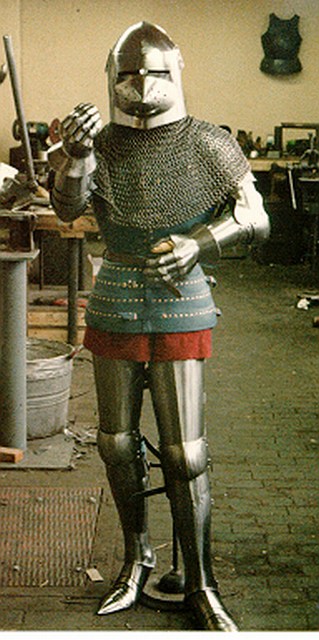
Reproduction Armour circa 1400
Reproduction armour. Torso armour of plates covered in leather and attached by brass rivets. Made by Wade Allen, Aaron Toman and Charles Davis working as Valerius Armouries.
Exhibited: Feb. 10 2023-Feb. 29 2024 Orange County Historical Museum Hillsborough NC
Not for sale.

Child's Halloween Costume circa 1400
Armour made as a halloween costume for a 5 year old. Composed of a bascinet with an aventail attached with tubular vervelles. Breastplate of simple globose form, rolls at the neck and arms. Spaulders, arms, Cuises with articulated poleyns, frontal greaves and sollerets of short pointed form. All on a wooden base. The armour was worn by Geoffrey for Halloween 2005. Tracy made a new grand assiette gambeson based on the Charles de Blois garment. The legharness is suspended from points on the arming doublet worn beneath the gambeson. The arms and spaulders are secured by points to the gambeson. Armour by Wade Allen, clothing by Tracy Justus. The armour was worn several times. When it was originally made it consisted of the bascinet (without aventail), breastplate, spaulders, arms and cuisses. These were designed to be constructed quickly, not to be strictly authentic in form. It was made over a 4 day period based on shrunk patterns from the days working as Valerious Armouries, two of which were just evenings after work. The vervelles, greaves and sabatons were made later to complete the look.
Exhibited: Feb. 10 2023-Feb. 29 2024 Orange County Historical Museum Hillsborough NC
Not for sale.

Armour circa 1440
Reproduction armour. Early 15th century german armour with 'Kastenbrust' breastplate. Breastplate taken from the surviving example in the City Museum of Vienna. Arms, pauldrons and clothing taken from the Knights of Christ from the Jan van Eyck altar-piece in St. Baron's Church, Ghent. Comprising breast and back with wide waist lames and 5 plate fauld/culet, breast with applied reinforcing strips at the arms and shaped stop-rib at the neck, standing collar of rivetted mail with shoulder length flaired cape, small pauldrons of 6 plates shaped to the shoulder, the lower 4 plates with long sliding rivets at the back to allow forward motion, arms with a near tubular upper, cop articulated to the upper and lower by one plate and fully-encased lower of tulip shape composed of an inner and outer plate attached by 2 hinges on the outside and strap and buckle on the inside. The images show how it was worn for Halloween. Afterward the legs with greaves were completed. The whole currently displayed together. Armour made of 1050 spring steel. Inner clothing of linen, outer of wool. Armour by Wade Allen, clothing by Tracy Justus. Constructed 2007.
Not for sale.
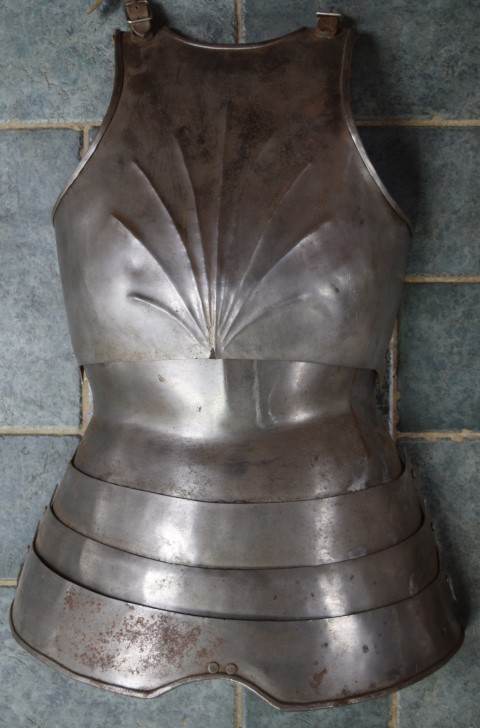
Kastenbrust cuirass circa 1440
consisting of a breast with fauld and back with culet. Forming a cuirass. Simple folds at the neck, arms and base of the fauld/culet. Breast with a central spray of flutes. Secured at the shoulders with straps and buckles, at the waist with spring pins.
Not for sale.

Italian armour in the western European style circa 1465
An extremely fine replica harness comprising armet, cuirass, mail collar, pauldrons arms, cuisses, greaves and gauntlets as they would have been built in Italy c. 1465. Made of hardened and tempered steel. The armour was assembled over time and purchased from various skilled armourers. It was adapted as required for wear in a very Italian form (with additional mail elements) and later in a more western European form. The armet was built originally as part of the project to explore English armour of the mid 15th c. and then used along with the rest to build a heavy calvalry armour first in the typical Italian style, then in a more western European or English style. The cuirass precisely reproduces the authentic shapes, thicknesses and weights of fifteenth-century Italian heavy cavalry armour, with a shot-proof breastplate and skirt, and mounted with a gilded lance-rest. Buckles and mounts gilt to match. Together with a matching pair of pauldrons and arms. The design of the cuirass, pauldrons and arms has been taken from two surviving Italian export armours in Switzerland, at the Bern Historical Museum and the Town Museum, Le Landeron. Cuisses were made in 2009. They were based on the cuisses currently displayed as part of the B1 armour in Mantova. The greaves were made separately, probably earlier, and the lower plate of the cuisse was adjusted to fit. The cuisses and greaves were originally fitted with mail in the Italian fashion (comprising a valence below the knee and full mail sabatons). The instep edge of the greaves are pierced for the attachment of the mail and the lower plate of the poleyne had a strip with holes to secure mail below the knee. At this time the mail has been removed for the western European fashion. Gauntlets were based off one in the Metropolitan Museum of Art in New York which is on display - 29.150.7j. The armourer was able to look at it and make tracings. Gauntlets were made in the summer of 2012. Toby supplied the buff gloves.
Cuirass, pauldrons and arms made by Per Lillelund Jensen. Cuisses, greaves and gauntlets made by Jeff Wasson to accompany the other pieces. This was most commonly worn with an armet made by Robert MacPherson in 2003. The armet is mostly a typical Italian style of the mid 15th c. but the visor is slightly adapted to represent a more English form.
The left elbow was adapted to match the hind tasset and to reflect an English usage as illustrated in the Hoo effigy. The armour was built as another experimental armour after the famous English armour built by Mac. This armour was worn for several years in jousts around the world and it was the armour that Toby wore as part of the work associated with Richard III's reburial and the work to recreate an armour for Richard III. Overall the armour survived its years in use very well. There seems to be one small dent in the left side of the lower breastplate, it has undergone various adaptations, and leathers have been replaced and pieces adapted as the wearer changed shape. Inspection of the left gauntlet cuff shows two points of damage. They come from one blow from a steel coronel on a solid wooden lance in the jousts at Schaffhausen when a blow went just a little low and two tynes of the coronel hit the guantlet.
The armour was purchased by the present owner in three parts. The first comprised the cuirass, pauldrons and arms. After that the legs and gauntlets became available and they were purchased to keep the harness together. The final part was the armet with some associated pieces. The harness was originally assembled over time as the parts were needed and made by armourers with the requisite skills and experience. Italian 15th c. armours, even when purchased as an armour, were often built by several armourers. At some point Toby had a new doublet made, so the one worn with this harness was also added to the collection. This doublet was worn with incarnations 6.3 and 6.4 of Toby's armour progression covering app. 2014-2016. It was made by Ninya Mikhaila and is one of a series she has made for Toby. It is covered in black wool with relevant arming points and cut to fit at the hips to allow for the suspesion of the legs and to allow full movement.
For a while (between the time the first and second portions were purchased) displayed with the legs that formerly formed part of R-15 made by Wade Allen in the mid 1990's. They are a fair match for the style of armour represented by the rest of the pieces. Armet manufactured by Robert MacPherson with riveted aventail made by Tobias Capwell which includes a wrapper. Then an exchange visor for foot combat was added (manufactured by Chris Dobson). The armet includes a gilded and pearl-fretted claw ornament which acts as a crest or plume mount which was built as part of the original English armour project by Robert Macpherson. Burgundian style upper arm voiders made by Toby in the Burgundian style and an arming doublet which illustrates how the small Burgundian voiders were worn. When the legs were re-fitted for Burgundian use the valences for mail were removed (valences present) and the shorter mail demi-sabatons are also present but not attached.
Not for sale.

reproduction armour circa 1470
Armour of basic Italian form. Breastplate of 'export' style. All parts hand made including the hinges, buckles and rosette-stamped washers. The legs were to R-37 temporarily. The legs displayed with this armour during this time were a somewhat earlier style of cuisses and shaped schynbalds originally made for other uses. They provide a complete, but not correct look. This image was taken with the original legs which have been returned after they were polished for use with R-37.
Not for sale.
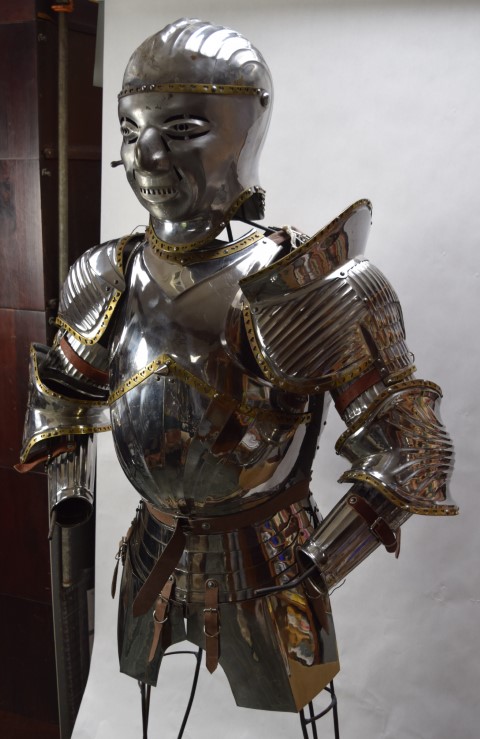
part armour late 15th-early 16th c.
Part armour consisting of a close helmet with grotesque face, cuirass of gothic form complete with fauld, cullet and front tassets, arms and pauldrons with narrow parallel flutes in the Maximillian form.
Not for sale.

Full Armour circa 1470
Designed and built after armour B2 from the Sanctuary of the Madonna Del Grazie in Mantova Italy. Armet with a bowl raised from one piece, cheek plates, sparrow's beak visor, wrapper and mail fringe. Cuirass formed of an upper breast and back joined by a hinge at the left and straps and buckles at the shoulders and right side, lower breast and back also joined with a hinge at the left and strap and buckle at the right with fauld and culet joined ensuite. The fauld carrying a pair of large one plate tassets and the cullet carrying a single wide tasset. Upper breast carrying a removable lance rest secured to the breast by a set of staples on the breast that engage holes in the lance rest, all held together by a steel wedge. Asymmetric pauldrons of 5 plates (right) and 4 plates (left) with reinforces The left larger providing more complete protection, the right cut out to allow for couching of the lance and additional movement. Asymmetric arms the right with a large wing, the left with an elbow reinforce. Cuisses with poleynes with large wings. Cased greaves with mail sabatons. Made for the Frazier International History Museum in Louisville, KY. This armour was built for their historical interpreters to use in arming the knight and longsword and pollaxe combat demonstrations. It was custom tailored for the head of interpretations J. Barrett Cooper. Made in 2005 by Jeffrey Hedgecock. Hardened and tempered 1050 steel. This and the other armour from the Frazier (R-43) were deacessioned after a change in focus. Sometime before the armour was purchased the gauntlets were lost. The stand used by the Frazier to display this armour was included with the purchase.
Not for sale.

Full Armour circa 1470
A late 15th c. full armour in the German style based on a wooden statue of St. Florian made by Michael Pacher as part of a parish church altarpiece. Salade of typical long tailed form with half visor. Bevor with a single falling lame at the top. Two piece breast and back with the lower plates rising to characteristic gothic points. Breast flutes and cusped edge treatments mimicing the statue. The breast and back carry a fauld and cullet, the fauld with a pair of tassets. A pair of symmetric pauldrons with besagues at the front, floating elbows and closed vambraces. Gauntlets with pointed cuffs, wrist lame, metacarpal of one small and one large plate, bluntly pointed knuckes, and individual finger and thumb with knuckle gadlings. All parts with characteristic fluting. Many details like the borders of the upper and lower poleyne plates, lower breastplate border, knee wing fluting and style of hinges specifically copied from the St. Florian statue. Some elements simplified (like the besagues) and others interpreted since they don't appear on the statue (like the bevor and salade). The armour was made for the Frazier International History Museum in Louisville, KY. This armour was built for their historical interpreters to use in arming the knight and longsword and pollaxe combat demonstrations. It was custom tailored for one of the interpreters, Tony Dingman. When it was made Tony was app. 6' tall and had a 38 inch chest. Made in 2007 by Jeffrey Hedgecock. Hardened and tempered 1050 steel. This and the other armour from the Frazier (R-42) were deacessioned after a change in focus. Sometime before the armour was purchased the sollerets were lost. Other obvious damage from its time at the Frazier include a bent terminal on one poleyne lame, the tip broken off of the other one and the thumb is lost from the left gauntlet where the thumb side of the hinge tore off. The stand used by the Frazier to display this armour was included with the purchase.
Weights: Salade 6 pounds 1 ounce (2750g), Bevor 1 pound 11.2 ounces (775g), Breastplate with fauld and 4 tassets 8 pounds 2.4 ounces (3690g), Backplate and cullet 5 pounds 1.6 ounces (2310g), Left arm 4 pounds 8.8 ounces (2070g), right arm 4 pounds 8.4 ounces (2055g), left gauntlet 1 pound 4.2 ounces - missing thumb - (570g), right gauntlet 1 pound 6.6 ounces (640g), right cuisse 3 pounds 14 ounces (1765g), left cuisse 3 pounds 14 ounces (1765g), left greave 2 pounds 4.6 ounces (1035g), right greave 2 pounds 5.4 ounces (1065g), mail collar 1 pound 7.6 ounces (670g), mail skirt 4 pounds 0.2 ounces (1820g). All weights as worn with straps, buckles and in the case of the helmet and bevor the linings and the gauntlets the gloves. one thumb, one terminal fleur and sollerets missing. Replacement thumb for the left gauntlet made by Wade Allen Sept. 2023. In its purchased state the plate is 45 pounds 2.7 ounces (20490g) mail 5 pounds 7.9 ounces(2490g)
Not for sale.

Salade circa 1470-1490
Open faced German. Center with flat topped crest line which changes to a central crease in the tail. Skull with nice form and flowing into a well formed side and tail. Bottom edge with narrow outward turned roll. Lining rivets securing a leather strap to which is sewn a quilted lining. Chin strap with Y ends secured to two additional, lower rivets. Overall a nice interpretation. Made of hardened and tempered spring steel. Made by Peter Polyak in app. 2017 from 2mm C45 steel which has been hardened and tempered. It was made as an example of a "typical" helmet, not as a copy of a particular one. Finished thickness generally .070-.080 in. (1.7-2.0mm).
Not for sale.
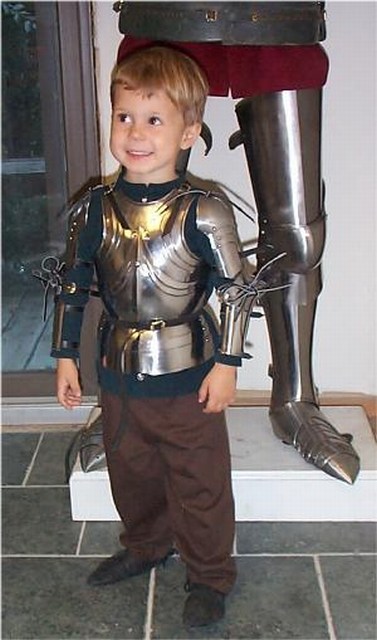
Geoffrey in Breastplate and arms circa 1480
Part armour. German style. Made as a costume for a 2 1/2 year old. Consisting of a breastplate and arms. The breastplate formed of an upper and lower breastplate, the lower carrying a fauld of three lames. The upper with small angular rolls at the neck and arms and with a pair of flutes inside the arc of the armholes. The lower rising to a central point with a simple fleur at the top and pairs of flutes bording the upper edge. The two pieces joined by a central bolt. The bottom edge of the lower breast flared to carry a fauld of three lames articulated at the sides with sliding rivets. The construction of the breastplate mimics item number A-330 which was added to the collection many years later. The arms of open form covering the outside of the arms, and consisting of a spaulder extended to the elbow, a floating elbow cop and a one piece vambrace. The spaulder with a large cop covering the shoulder secured to the upper cannon by two lames. The cop and two lames with three points on the lower edge. The plates are secured by sliding rivets at the back and leathers at the center and front. The spaulder, cop and vambrace secured by a pair of laces above and bellow. Worn with a doublet, pants and turnshoes. Patterns made by scaling down the patterns for a simple pair of arms designed by Wade and Aaron in the 1980's working as Valerius Armouries and scaled down breastplate from one Wade made in the early 1990's. Arm patterns require two of of the small pieces between the spaulder cop and cannon. I don't remember what was used for the third fauld lame. Armour and turn shoes by Wade Allen, doublet by Tracy Justus.
Not for sale.

Geoffrey in Cuirass and Helmet circa 1480
Breast back and helmet. Made for Geoffrey at 5 3/4 in Oct. 2004. The breastplate patterned loosely after several currently and formerly held in the armoury at Churburg. These are usually described as for infantry use and may often have originally worn without a backplate. It is formed of a simple upper and lower breastplate and fauld of three lames. The upper breastplate with narrow angular rolls at the neck and arms and a simple angular flute below the neck mimicing earlier stop ribs. The lower rising to a central point and with a central flute. Bottom edge flared to carry the fauld of three lames carried on sliding rivets at the side and a central leather. The backplate is patterned loosely after one formerly held in Churburg and now in the Royal Armouries. Formed of two pieces, the upper overlapping the lower. Upper with flat rolls at the arms and the neck cut into a shallow V. The bottom edge of the upper plate rising at the center and pierced with a simplified spade. Lower carries a three plate fauld each plate rising to a point at the center. Helmet of simple open faced barbute form. The bowl rising to a shallow central crest, tail flared to the neck and the lower edge rolled. Worn with a linen doublet. The pattern was used to make the helmet. Construction followed the "can" technique - two of the top pieces are welded down the center and the resulting piece welded to the bottom forming an angular shape. Then the ridge around the sides is pushed in hot to form the bowl. Once the top was shaped the neck was raised in. The patterns are on a 1" scale.
Armour by Wade Allen, doublet by Tracy Justus.
Not for sale.

Late 15th c. German harness for a child circa 1490
Armor made for a child as a Halloween costume. After it was used by the owner it was used in a photo shoot for a cover for "Sports Illustrated for Kids" from the 1990's which included articles on protective equipment for sports. A full armor with accessories. Armor consists of: Salade, bevor, 3 piece arms with besagews, fingered gauntlets, cuirass with fauld and tassets, cuisses with poleynes, greaves and sollerets. Accessories included arming garment with attached mail voiders and skirt, sword, halbard, buckler, jousting targe, shield, spurs a stand for the armor and stand for the accessories. Original stands lost over the years. Designed to be an example of a German "gothic" full armor. Probably the most complete armor panoply made for a child in modern times. Images without the helmet show the first test fit of the armor on a new stand after it was cleaned to remove the rust that formed in storage after it was returned from the photo shoot. The salade was initially thought to be lost, but it was later found and restored to the armour.
Armor, mail and accessories made by Tom Justus. Main gauntlet plates by Wade Allen. Arming garment by Tracy Justus.
Made 1994-1995.
Exhibited as part of a display of reproduction armor at the North Carolina Museum of Art along with Three other armors and 6 helmets. Two armors made by Tom, two by Wade. Three helmets by Tom, two by Wade and one from the collaboration between Wade and Aaron Toman.
Not for sale.
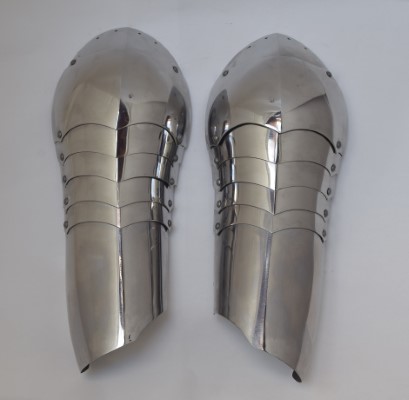
Pair of Spaulders circa 1490
Of simple "Gothic" form typical of the work from Innsbruck. Patterned after those on A20 in the Wallace and other similar surviving shoulders, not intended as a direct copy of any of them. The primary source was A20, but some others have more interesting sweeps in the overall form - this has been incorporated. The top plates are attached to the main plates with sliding rivets at the front and back. The lower plates are secured by sliding rivets at the back and leathers are the center and front. They were sized to fit me. They are illustrated when first finally assembled, they still need leathers and a buckle. The other image shows the initial full sized sketches drawn to work out the form in detail with the rough bolted together pieces. The drawing on the left includes the intended overlaps. The drawings have enough detail that I was able to derive the patterns directly from the drawings. Made by Wade Allen in 2023. Hardened and tempered 1050.
Not for sale.
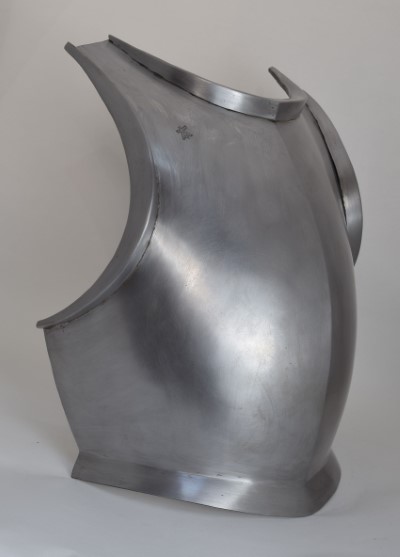
Breastplate circa 1490-1500
Based on item number A-66. Started as an illustration of raising by Patrick Thaden at The Forging held in Booneville NC in 2019. Raising completed later in live Facebook streams, then the rolls formed in additional live videos. Forming involved very few tools, none of them specialized. The work was performed hot using an O/A torch. The hammer was an old 12 ounce ball pien and the piece was supported during both raising and rolling by one of two mushroom stakes. This is a fine example of shaping and a masterclass in large outward rolls.
Constructed of mild steel, starting with 12g (app. .105 inch). Final thickness near the center crease varies but is generally .105 inch or a little thicker. It thins down to .076 inch under the arms. Neck roll .625 tall at the center, tapering to .25 at the ends. Arm rolls rise to app. .76 (left) and .85 (right) tall and .96 (left) and 1.04 (right deep) at the center. Weight 5 pounds 11.4 ounces (2590g).
Not for sale.

Salade circa 1495
Expertly designed and built by Francois L'Archeveque. Based on A-62 KHM and similar helmets, but not intended as a direct copy. Somewhat simplified with a roll at the lower edge instead of applied copper alloy border. Complete with fine engraved decoration, interior visor reinforce and elegant double heart piercing at the center of the crest. Made by the modern armourer with a really great eye for salades. Formed of mild steel with an intentional thickness change between the top and the sides and back mimicing the construction of the high quality helmets of the time. The general concept was agreed to with Francois, but Francois was allowed to choose the details of the form to make the prettiest salade of this type he could.
Weight: 7 pounds 13.4 ounces (3565g).
Not for sale.

Barbute and Chapel de Fer 15th century
2 helmets. The left one is a mid 15th c. barbute. The right one is a chapel-de-fer patterned after one in the Metropolitan Museum of Art in New York.
Not for sale.

Armet circa 1500
Armet a Rondel. Bowl raised from one piece, full reinforce covering the front of the skull. Visor raised, with covered hinges. Armour by Wade Allen
Not for sale.
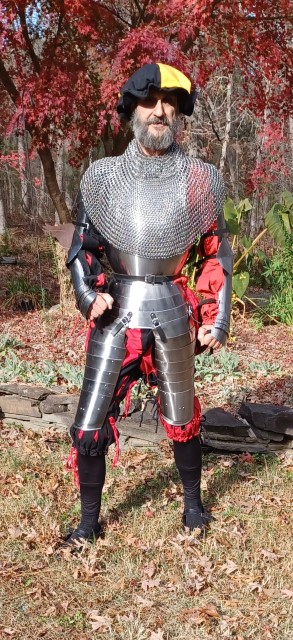
Breast, back and Tassets circa 1500
Breast of plain rounded form with large angled inward-turned roll at the neck and small inward-turned rolls at the arm holes. Fauld of 3 lames, the terminal lame with a narrow inward turned roll at the lower center. Back plate of three pieces, one large central plate with small plates extending under the arms. Tassets. Armour by Wade Allen 2023 (back plate designed and formed for use with a different breastplate in 2018) in 2023. Heat treated 1050. Buckles by Clang Armory. Worn with a cheap costume from Medieval Collectibles. Mail is an old aventail used to simulate a bishop's mantle. It's not right at all, but it fills in some gaps nicely. The pictures show me wearing the breast, back and tassets along with item number R-51.
Not for sale.
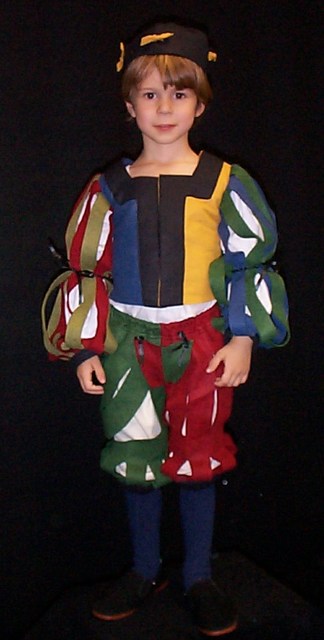
Geoffrey in puffed and slashed costume circa 1510
Costume for 4 1/2 year old. Costume by Tracy Justus
Not for sale.
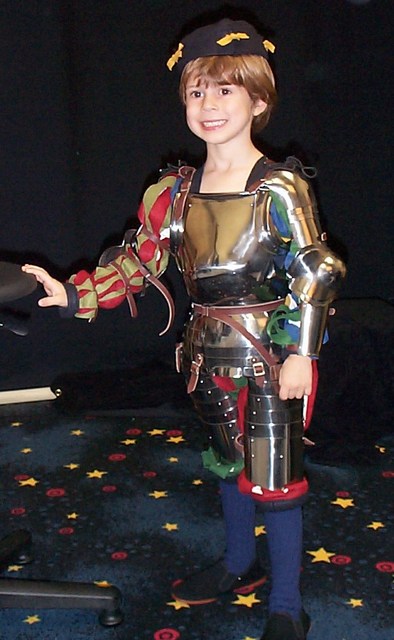
Geoffrey in three-quarter suit circa 1510
Breast, back, tassets and floating arms for a Landsknecht costume for 4 1/2 year old. Breastplate with sliding gussets and waist lame. Large inward rolls at the neck and arms. Floating elbows on simple splint arms. Three piece backplate. Armour of 18g. and 21g. 1050 spring steel. Armour by Wade Allen, Costume by Tracy Justus
Not for sale.
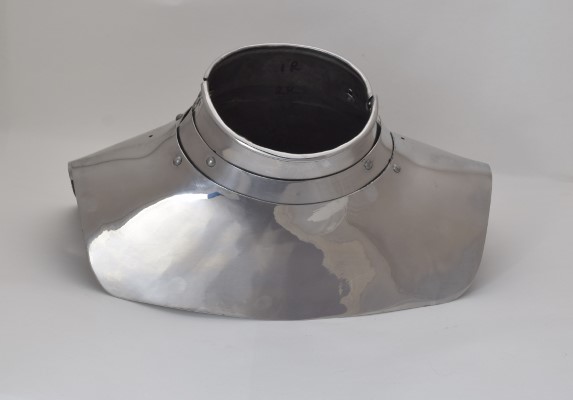
Gorget circa 1510
Gorget based on item number A-226. Patterns show the tape over plastic wrap that was used to pull the patterns directly from the original piece and the actual templates used to make the reproduction. They are on an inch scale. This piece, like the original, is designed to be assembled in a very atypical way. The neck lames are attached to the main plates with sliding rivets instead of leathers and the hinge is on the right instead of the left. Continuing the oddities, the main plates are not attached to each other except by the neck lames. I found the initial life-sized sketch I did for the project. This is a great way to work out details of the size and form without wasting a lot of steel. It would have been a lot better if I hadn't overlapped the front/back and side views. This makes the details hard to work out. The right side shows a front view of the planned gorget, breast and arms. The left includes a view of the planned backplate but also has the side view laid on top of it. If you look carefully you can see what was going on. I made the gorget, breast, back and arms. In the drawing you can see two different possible profiles for the breastplate. I guess I never really decided which one I liked, so the breast sort of went off the rails. As of 2023 it is still rough and unfinished. I moved on to a different breastplate designed to be used without a gorget instead. The profile view of rough armor on the fiberglass cast body double shows the "failed" breastplate.
Not for sale.
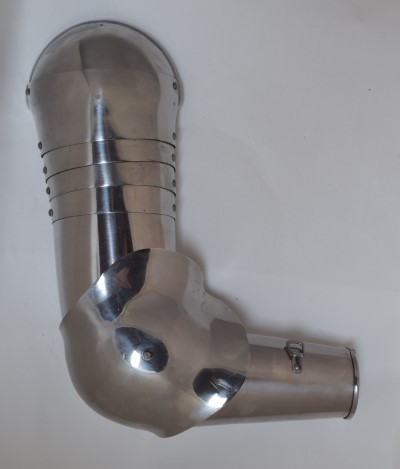
Pair of Arms circa 1510
Consisting of spaulders, floating elbows and closed vambraces. Spaulder shaped to the shoulder formed of a large main plate with an additional plate above, three narrow lames and a large termial plate. Top two plates with a narrow inward turned roll at the top extending onto the front and back of the second plate. Lower plate shaped to the elbow. Large plain shell formed elbow cops extending app. 2/3 of the way around the elbow. Vambraces shaped to the elbow, formed of an inner and outer plate hinged by a pair of external hinges at the back and a strap and buckle at the front. Narrow outward turned rolls at the wrist and inside of the elbow.
Not for sale.
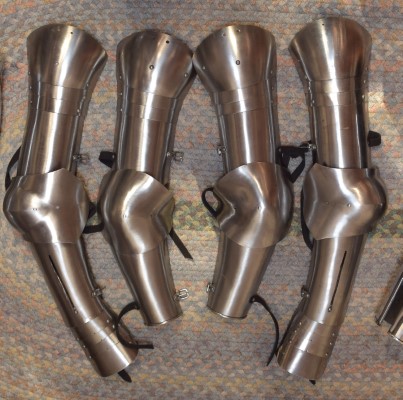
Pair of Splints circa 1510
Simple form covering the outside of the arms. Consisting of a simple spaulder, floating elbow and one piece vambrace Made by Wade Allen in 2022-2023. Heat treated 1050.
Not for sale.

Pair of Splints circa 1510
Simple form covering the outside of the arms. Consisting of a simple spaulder, floating elbow and one piece vambrace. Vambrace with integral protection for the back of hand secured to the vambraces with a rivet through a long slot. Made by Wade Allen in 2022-2023. Heat treated 1050.
Not for sale.

Breastplate, fauld and long tassets circa 1540
Breasplate with fauld and tassets. Includes recessed polished bands, sliding gussets and hand made buckles and washers.
Not for sale.

Armour circa 1540
Reproduction of a black and white half armour. Composed of breast, back, and gorget with munions over a doublet and slops.
The breastplate has a central crease which is drawn out to a rounded point somewhat below the center. The upper edge is rolled inward. The roll tapers from the center. The arm holes have sliding gussets. The gussets have large, hollow, inward-turned rolls. The breastplate was raised from the flat. A weld at the bottom would have been a lot easier, but I didn't do it that way. The gussets are made from straight strips and flaired to create the roll and to fit into the breastplate. The breastplate has a simple fauld of 2 lames. The lower lame has a small rolled arch at the center. The back plate is fomed of one piece with a separate waist lame forming a degenerate culet. The back is shaped agressively to the shoulder blades almost forming a point over each. The gorget is formed of 2 neck plates front and back, a large main plate front and back and shoulders of 7 lames. The neck lames are secured by 3 leather strips front and back. The shoulder plates are secured by sliding rivets at the back and interior leathers at the center and front. The smaller rolls on the top plate of the gorget, backplate and at the center of the lower fauld lame are turned over wire. The rolls on the bottom edge of the munions are just turned without wire. All of the rolls go 'in' (as appropriate for 16th c. armour). The plates are rough from the hammer with a painted black finish with raised bands of polished steel. Worn with morion A-152.
Thicknesses: breastplate .062, fauld .050, backplate .050, main gorget plates .050, munions .035.
The clothing consists of a shirt, doublet and slops. Socks and shoes are modern. The shirt is based on one in the Victoria and Albert museum in London from 1540-65. It is featured in Janet Arnold's Patterns of Fashion 4. It is assembled in the same way as the original, by finishing the individual pieces and then butting them together and (machine) embroidering over the two pieces to hold them together. The main pieces are held together by the embroidery. This copy omits the frill at neck and wrists. The doublet is fulled wool lined throughout with linen. The white on the sleeves is a layer of silk between the linen sleeve lining and the slashed wool outer sleeve. All three layers are stitched together and treated as one. The wrist openings are bound with a narrow facing. The buttons are based on some found in the Mary Rose. They are formed by covering some 7mm beads with wool which are attached by stitching through the center which gives that little dimple in the center of the button. The diagonal slashing on the sleeves frays very little. The slops are fulled wool lined with linen. The white is a layer of silk between the lining and the wool strips (panes). A rotary cutter is an excellent tool for cutting panes. They were worked flat, mounting the silk onto the linen lining and then laying the panes over that. Then they were assembled into pants. The leg opening is finished with a narrow facing and the waist has a wide waistband. The fly opening is modified in deference to the wearer by adding an invisible zipper (instead of points) and reducing the codpiece to a nearly flat flap (instead of something aggressively masculine).
Geoffrey is riding Bruce(Callaway's North Wind) his 12 year old Saddlebred.
Armour by Wade Allen, Clothing by Tracy Justus.
Not for sale.
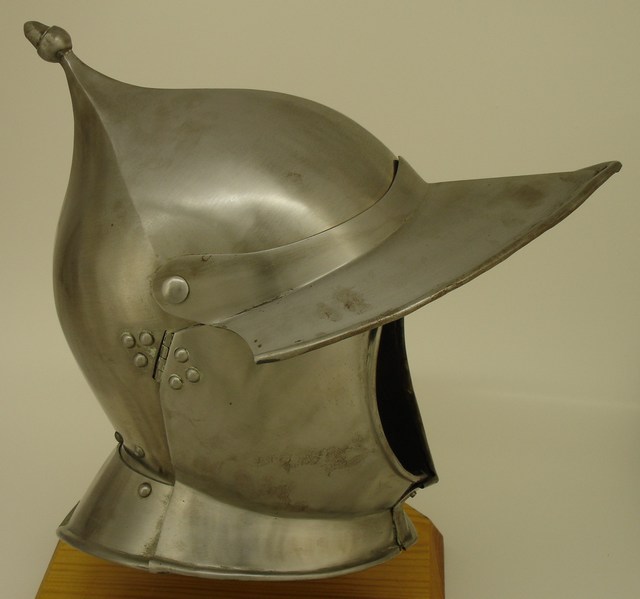
Burgonet circa 1550
Burgonet with acorn finial. Bowl raised from a cone. Moveable umbril and cheeckpieces that attach with a pin at the chin. Lined with an authentic linen lining of 2 layers stuffed with tow and quilted. All hand stitched. patterned after the burgonet lining in the Allen collection. Stitched to leather strips which are riveted along the face and neck edges of the bowl. Armour by Wade Allen, lining by Tracy Justus.
Not for sale.

Armour mid 16th c.
A part armour consisting of arms with connected pauldrons, breast and backplate, gorget and legs.
Not for sale.
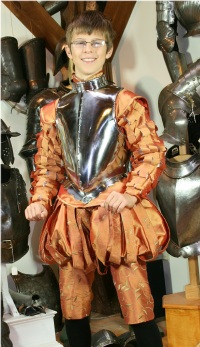
Waistcoat Cuirass. circa 1570
Italian. Formed to mimic the peascod style of civilian clothing popular at the time with a waist that droops at the center of the waist. Arms and neck bordered by inward-turned roped rolls. Waist flaired and cut to form picadills. Formed of five main pieces. The main front and back plates solidly at the side and shoulder. These units are then secured to the central back plate by two hinges and an alignment pin on each side. The front is decorated with a line of pointed buttons and secured by a hook through a hole in a peg at the base, a turning hook in the center and a pin in the gorget plates. The neck is extended to form an integral gorget. The gorget, like the cuirass, is formed of 3 separate pieces. One that extends the central back plate, the others that cover the sides and join at the front. The Italianate details include the form of the peascod (more rounded) the overlap at the center (many German ones just overlap to the center), the buttons down the center, and the relatively straight form of the gorget plates. All of the turns have wire inside.
The waistcoat cuirass was based on several surviving Italian waistcoat cuirasses. These included examples in the Wallace collection, Chicago Art Institute, etc. Primary design was taken from one that survives in the Odescalchi collection in Rome in the Museo di Palazzo Venezia #1251. It is illustrated in figures 167 and 168 in Armi e Armature Lombarde. Since this was made we have added item number A-240, an example of a similar type of cuirass.
Tracy was allowed to design the clothing to suit Italian styles of the appropriate period. The outfit was inspired by a 1560 portrait by Giovanni Moroni, ""The Man in Pink"". It is made of silk and linen. Additional sources include a couple of outfits described by Janet Arnold in Patterns of Fashion 3 to pattern it: the 1562 grave clothes of Don Garzia de Medici and the 1618 suit of Sir Richard Cotton. There are a couple of deviations from period practice for the comfort of the wearer - the doublet and breeches do not lace together and there's a zipper behind the codpiece. The overall look is good. Geoffrey is tall and slim so he has the right physique to pull off this kind of thing. Embroidered silk-covered bead buttons.
Formed from 14g for the breast plates, 16g for the back plates and 20g for the neck plates. Full-wrap hinges formed of 20g. All of 1050.
Armour by Wade Allen, clothing by Tracy Justus. Produced for Geoffrey Allen when he was 12.
Not for sale.

Armour circa 1580
Reproduction armour. 2nd half of the 16th century munition armour. All pieces rough from the hammer and blackened. Buckles and washers of iron. Washers of rosette form and dapped in each petal. Buckles based on the surviving buckles from the tassets on the 3/4 harness A-1 in the Allen collection. Spaulders based on A-117 in the Allen collection. Composed of breast, back, gorget, tassets and shoulders. The associated morion and halbards are authentic pieces (all are of the correct style to be used with the armour). All rolls turned inwards and hand formed (without a jenny). Worn over a padded silk doublet and velvet venetians and with a velvet half cape lined with linen. The doublet is shot silk lined in linen. The venetians and cape are made of cotton velvet. The buttons on the doublet and venetians are cast in pewter and based on the ones on the leather doublet in the Museum of London. The doublet is generally based on the Heaver castle arming doublet, the collar is base on the Don Garcia di Medici one and adds a small skirt based on contemporaty paintings. The pattern for the venetians and half cape were taken from Janet Arnold. Armour made by Wade Allen, clothing by Tracy Justus. Mounted on Secret Agent - one of the horses Geoffrey uses in his riding lessons at Winslow Stables. Constructed 2008.
Not for sale.

One gauntlet circa 1580-1600
One of a pair. Made for the Higgins Armory Museum in the mid 80's by Valerius Armouries (Wade Allen and Aaron Toman) as part of a pair. These were made along with a barbute, great helm, and a pair of 15th c. Italian gauntlets for use in their education program.
Not for sale.

Breastplate circa 1590
Breastplate. Simple peascod form. Raised from one piece. Rolls at the neck and arms. Flair at the waist.
Not for sale.

Half Armour circa 1600
Made for the Higgins Armory for their educational program.
Not for sale.

Cuirass and Sword circa 1620
Cuirass and simple rapier for a musketeer costume for 3 year old. Armour of 18g. 1050 spring steel.
Not for sale.

Shop picture circa 1985
A picture of page 40 from TOMAR showing the Valerius Armouries shop on Farwell Ave.
Not for sale.

TOMAR Valerius Armours items circa 1985
A picture of page 41 from TOMAR showing a few items Aaron and I made working as Valerius Armouries and a few items I made later.
Not for sale.
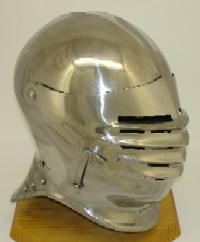
Bellows Face Close Helmet Early 16th century
Close helmet with bellows visor. Armour by Wade Allen and Aaron Toman working as Valerius Armouries.
Not for sale.